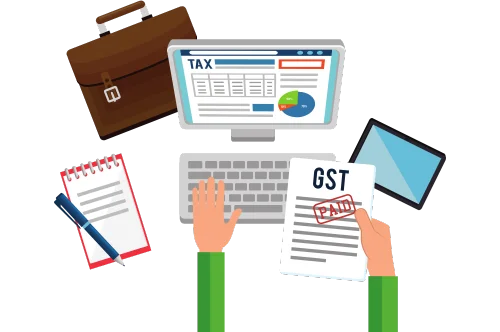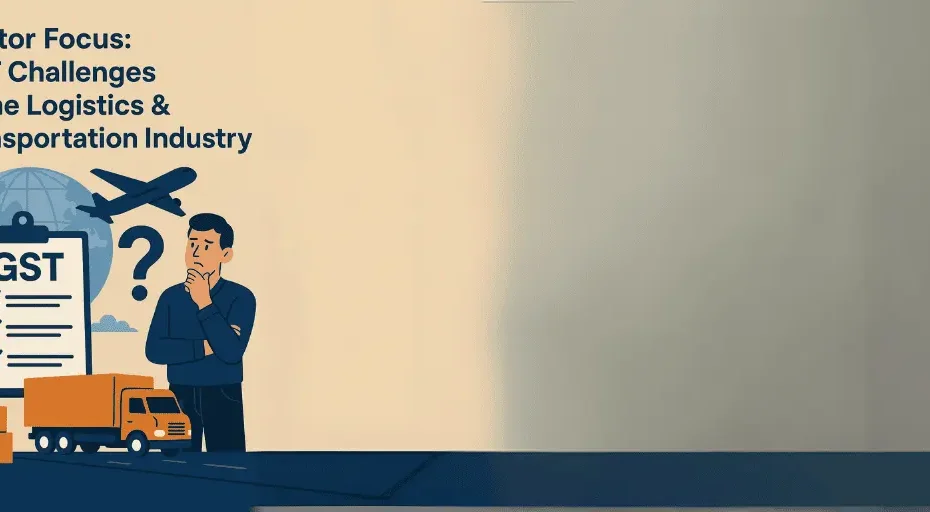Sector Focus: GST Challenges in the Logistics & Transportation Industry
The introduction of the Goods and Services Tax (GST) in India was a landmark reform aimed at unifying the country’s fragmented indirect tax system. While it brought transparency and efficiency to many sectors, it also introduced a unique set of challenges—particularly in the logistics and transportation industry. As this sector forms the backbone of economic movement, addressing the issues related to GST in transportation is crucial for smoother operations and sustained growth.
Understanding GST in Transportation
The transportation industry involves the movement of goods and services across state and national borders. Under the GST regime, different modes of transportation—road, rail, air, and sea—are taxed differently. GST in transportation applies based on the type of service offered, whether it involves the movement of goods or passengers, and whether the service provider is registered.
Road transport services offered by Goods Transport Agencies (GTAs) attract GST, with different rates depending on whether the reverse charge mechanism (RCM) applies. Passenger transport services via air or rail also have specific GST implications. However, despite these structured classifications, the real-world application of GST in transportation has proven to be complex and problematic.
Key Challenges of GST in Transportation
1. Input Tax Credit (ITC) Difficulties
One of the most pressing challenges under GST in transportation is the availing of Input Tax Credit. Many logistics providers work with a network of subcontractors, who may not always be GST-compliant. This makes it difficult to claim ITC on their services. Also, due to poor documentation and mismatched invoices, companies often find their ITC claims being rejected.
To add to the issue, transport operators often deal in cash-heavy transactions and small ticket purchases such as fuel and repairs. These inputs are not always linked to GST-compliant invoices, which further limits ITC eligibility.
2. E-Way Bill Complications
The e-way bill system was introduced to track the movement of goods and prevent tax evasion. While conceptually sound, its implementation has faced several glitches. Businesses frequently encounter issues like system downtime, mismatched entries, and penalties for minor clerical errors.
For companies that rely on multimodal transport—say a truck and then a rail journey—complying with e-way bill requirements can become a bureaucratic nightmare. These operational hiccups add a layer of inefficiency to the overall framework of GST in transportation.
3. Classification Ambiguity
Correctly classifying services is critical under GST. But in the transportation sector, the line between composite and mixed supply is often blurred. Is packaging part of logistics or a separate taxable service? Are loading and unloading bundled with transportation?
Due to inconsistent rulings and lack of industry-specific guidance, businesses struggle to correctly classify their offerings. Incorrect classification can result in fines or denial of ITC, which impacts the profitability and compliance standing of transport companies under GST in transportation.
4. Interstate Movement and Multiple Registrations
Another critical issue faced by transportation firms is the requirement of multiple GST registrations across states. If a company operates warehouses and hubs in various locations, it must register in each state, file separate returns, and maintain distinct books.
This requirement adds to the compliance cost and complexity. Even small logistics players find themselves burdened by the paperwork and reporting demands of GST in transportation when operating across state borders.
Impact on Business Operations
The logistical sector, which was expected to benefit from a unified tax regime, now finds itself tangled in layers of compliance. GST was supposed to eliminate check posts and speed up interstate movement. While it has succeeded in removing physical barriers, digital and procedural bottlenecks still remain.
Frequent changes in GST rules, amendments in rates, and notifications about applicability have made it difficult for logistics companies to keep up. The situation is particularly hard for small transport operators who lack dedicated compliance teams. For them, GST in transportation is not just a tax but an operational challenge that affects cash flow, efficiency, and competitiveness.
Digital Transformation and GST in Transportation
On a more positive note, GST has nudged the industry toward digitization. Many logistics companies have started investing in ERP and TMS (Transport Management Systems) to streamline GST invoicing, e-way bill generation, and ITC matching.
This digital push, though costly initially, may benefit the industry in the long term by improving transparency, reducing human error, and enhancing overall efficiency. Companies that embrace technology can better manage the evolving demands of GST in transportation, stay compliant, and focus on scalability.
Recommendations for Smoother GST Implementation
To alleviate the current issues and make GST in transportation more efficient and business-friendly, the following reforms are recommended:
Centralized Registration Option: Allow large logistics operators to have a centralized GST registration to reduce compliance costs and administrative burden.
Clearer Service Classification: The GST Council should issue comprehensive guidelines for classifying logistics services and related activities.
E-Way Bill Simplification: Improve the portal’s usability and eliminate penalties for minor clerical errors, especially in multi-leg transport scenarios.
Vendor Compliance Tracking: Provide businesses with better tools to track vendor GST compliance for seamless ITC claims.
Grievance Redressal Mechanism: Establish a faster dispute resolution system for addressing ITC mismatches, e-way bill issues, and classification disputes related to GST in transportation.
The Way Forward
Despite the hurdles, GST has the potential to transform the logistics and transportation landscape in India. By streamlining indirect taxes and promoting inter-state trade, it lays the groundwork for a more integrated economy.
However, for this potential to be fully realized, policymakers must continuously refine the framework. Stakeholder consultation, digital support, and sector-specific clarity are essential to ensure that GST in transportation becomes an enabler rather than a bottleneck.
Transport and logistics companies, on their part, must stay updated with GST changes, invest in technology, and educate their vendors about compliance. A collaborative approach between industry and government is key to unlocking the full benefits of GST.
Conclusion
The logistics and transport industry plays a vital role in the Indian economy, and the importance of addressing GST-related challenges in this sector cannot be overstated. While GST has created a common tax structure, the path to compliance is still riddled with practical difficulties.
Understanding the nuances of GST in transportation, adapting to regulatory shifts, and embracing digital tools are no longer optional—they are essential. As India moves toward a more formal and tech-driven economy, overcoming the GST hurdles in logistics will be a crucial milestone in that journey.
Our GST Services

All E-commerce Tax services
E-commerce tax services help online sellers navigate GST registration, compliance, return filing, TCS management, tax planning, and audits, ensuring efficient tax management and legal compliance.

GST Filing
GST filing is the process of submitting tax returns to the government, detailing sales, purchases, and taxes paid or collected, ensuring compliance with GST laws.

GST Registration
GST registration is the process where businesses obtain a GSTIN from the government, allowing them to collect taxes, claim input tax credits, and comply with GST laws.





